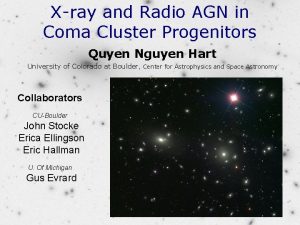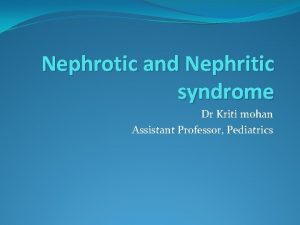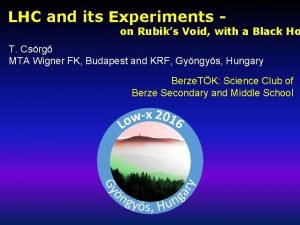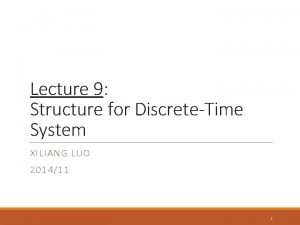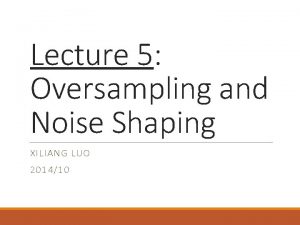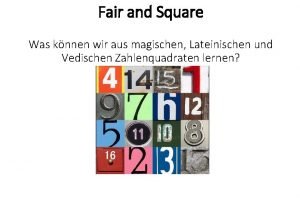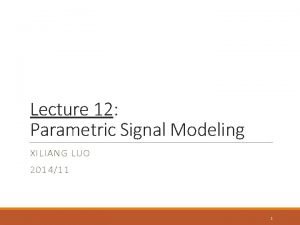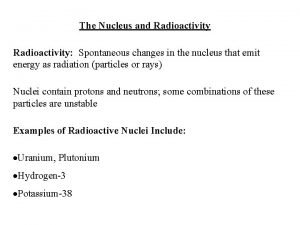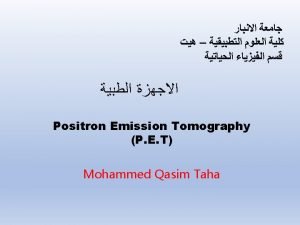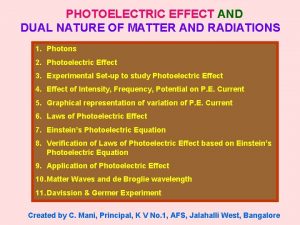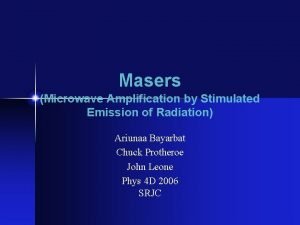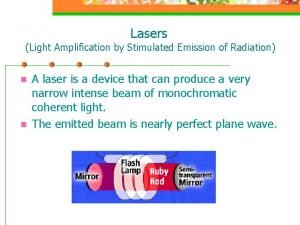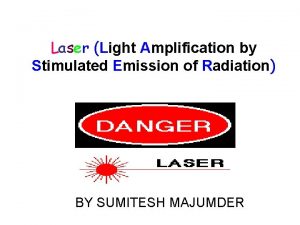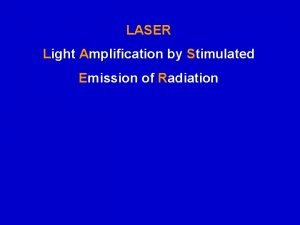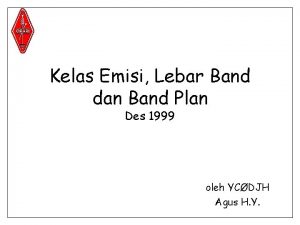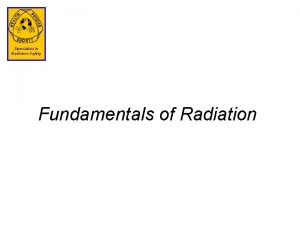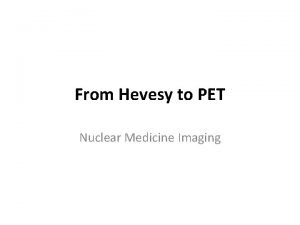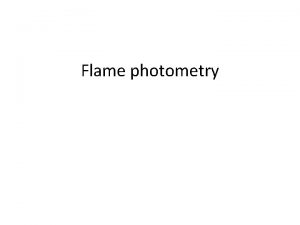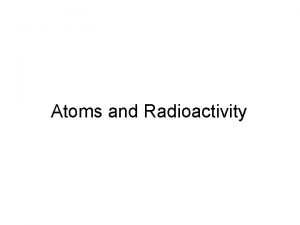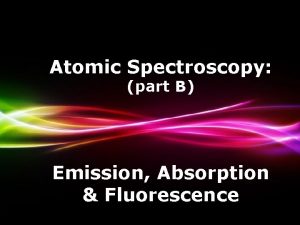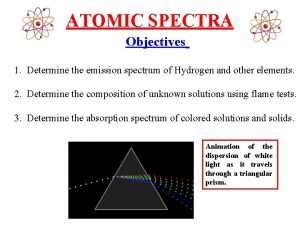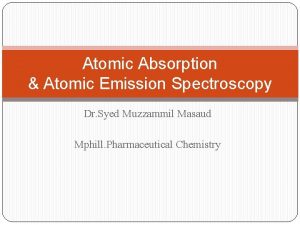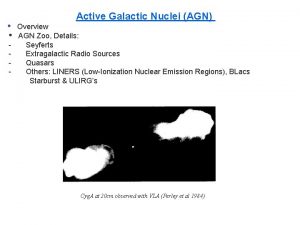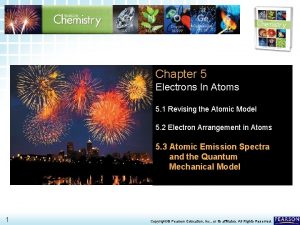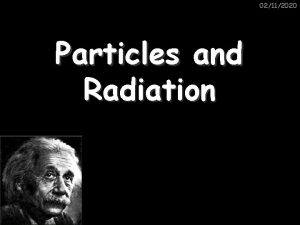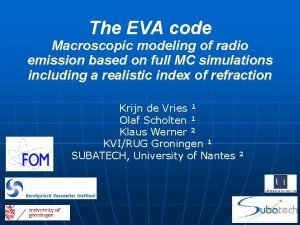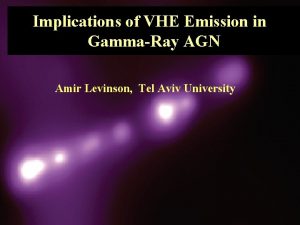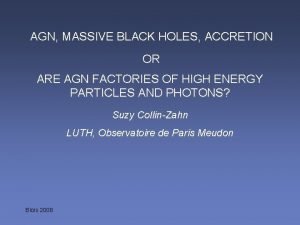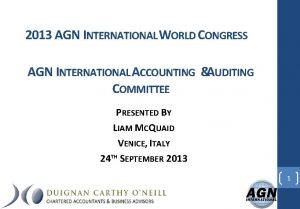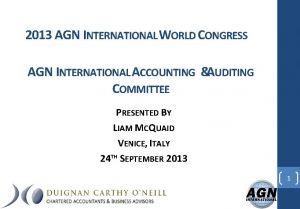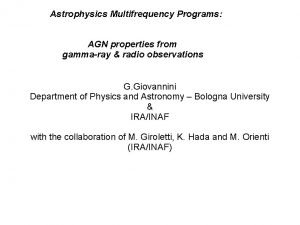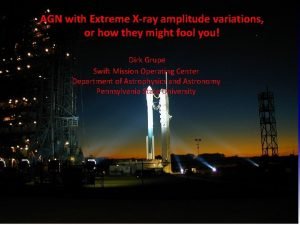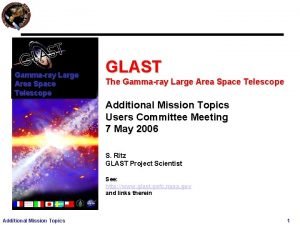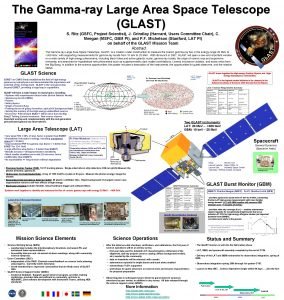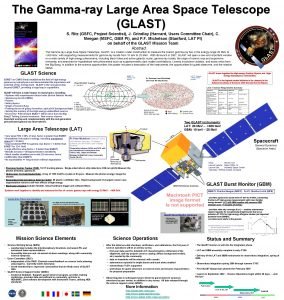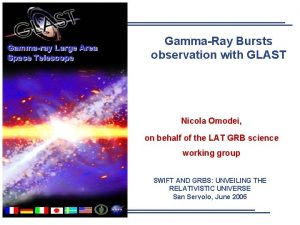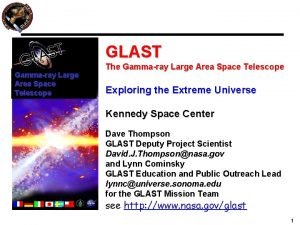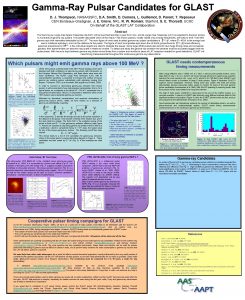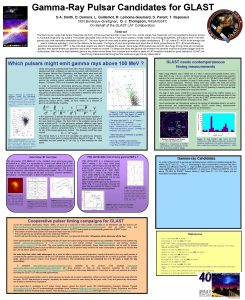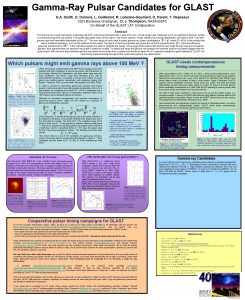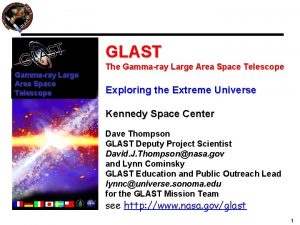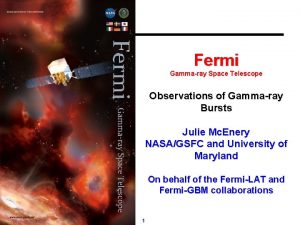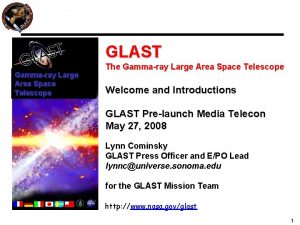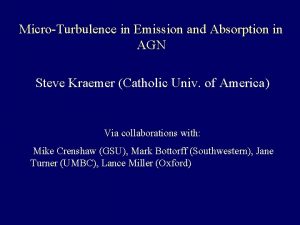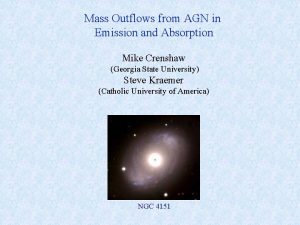Gammaray emission from AGN Qinghuan Luo School of






































- Slides: 38

Gamma-ray emission from AGN Qinghuan Luo School of Physics, University of Sydney ICRR 17/9/2001

Blazars • EGRET sources: Most of them are AGN Third EGRET Catalog • Diffuse -ray background: - Unresolved blazars or - Exotic processes e. g. annihilation lines from supersymmetric particle dark matter or unstable particle relics? ICRR 17/9/2001 (Hartman et al 1999)

Mk 421, Mk 501 ICRR 17/9/2001

3 C 273, 3 C 279 ICRR 17/9/2001

Rapid variations Mk 501 ICRR 17/9/2001

Overview • Blazars (BL Lac, FSQ): Relativistic jets directed at a small angle to the line of sight. • Intraday variability (IDV): small scales; large . • Relativistic jets, contents, acceleration/deceleration. • Emission mechanisms: SSC vs ERC? • Emission from decelerating/accelerating jets? ICRR 17/9/2001

High energy spectra of blazars • At least two components: IR-UV (perhaps up to X-rays) and above hard X-rays • High energy range is power-law, =-∂ln. L /∂ln. E≈0. 6 -1. 6 for EGRET blazars • Te. V -rays; No evidence for -ray absorption due to pair production ICRR 17/9/2001

Te. V -rays from Mk 421, Mk 501 : Mk 421 (Krennrich et al 1999) ICRR 17/9/2001

Escape of Te. V -rays A large is needed to explain IDV in -ray emission from Mk 501 • Absorption of Te. V -rays via + e++e-. Photon number density nph≈F d 2/(c 3 t 2 var. D 4) (Protheroe 1998) • The maximum photon energy: ph~D maxmec 2 in the KN regime; ph ~15 Te. V requires D ~30 for =106. ICRR 17/9/2001

Te. V flares -Intraday variability (possibly ~ hrs) requires relativistic beaming! ICRR 17/9/2001 Mrk 501

Radio IDV PKS 0405 -385 (Kedziora-Chudczer et al. 1997) ICRR 17/9/2001

The brightness temperature problem -VLBI measurement: • Space-based VLBI survey: the highest Tb=1. 8 1012 K (0133+476) (Lister et al 2001; Tingay et al 2001). • The intrinsic brightness temperature: T’b=Tb(1+z)/D, D=[ ( bcos )]-1 -Variability brightness temperature: Tvar= S d 2/ 2 2 t 2 var In the jet frame T’var~Tvar/D 3 e. g. for PKS 0405 -385, Tvar= 1021 K! (Kedziora-Chudczer et al. 1997) ICRR 17/9/2001

Constraints on Tb • Synchrotron self-absorption: Tb≤ mec 2 /k. B • Inverse Compton scattering (Kellermann & Pauliny-Toth 1969) • Equipartition (Readhead 1994) • Induced scattering: -Induced Compton scattering (k. Tb/mec 2) T≤ 1 (e. g. Coppi, Blandford, Rees 1993; Sincell & Krolik 1994) -Induced Raman scattering and possibly other processes -Coherent processes is not favoured ICRR 17/9/2001

Interpretation of radio IDV • Various models - Extrinsic: Interstellar scintillation - Intrinsic: Coherent emission; Geometric effects (Spada et al 1998) Synchrotron radiation by protons (Kardashev 2000) Non-stationary models (Slysh 1992) • Relativistic bulk beaming with >10 needed? IDV may be due to both intrinsic effects and scintillation. ICRR 17/9/2001

Relativistic bulk motions • Rapid variability, high brightness temperature require relativistic bulk motion with a higher . • Continuous jets or blobs? • Observations of -ray flares, IDV appear to suggest the source region being close to the central region. • Both acceleration and deceleration of the jet can occur in the central region. • VLBI observations: ≤ 10. The limit of VLBI or acceleration mechanisms or radiation drag (e. g. Phinney 1987)? ICRR 17/9/2001

Superluminal motions - Measured obs gives only the minimum . -D from beaming models: Sobs=S 0 Dp (e. g. Kollgaard et al 1996) RBLs E=log(Pc/Pex) ICRR 17/9/2001

Formation of jets • Acceleration mechanisms: no widely accepted model. - The unipolar model: Blandford & Znajek (1977), Macdonald & Thorne (1982) - “Twin exhaust’’ model: Blandford & Rees (1974) - Radiation acc. : O’Dell (1981) - Acc. by tangled magnetic fields: Heinz & Begelman (2000) • Radiation drag: - Radiation fields from the disk and jet’s surroundings decelerate the jet Phinney (1982, 1987): ~ eq < 10. Sikora et al. (1996) ICRR 17/9/2001

Emission mechanisms: SSC vs ERC • Synchrotron self-Compton (SSC): (e. g. Konigl 1981; Marscher & Gear 1985; Ghisellini & Maraschi 1989) Synchrotron photons are both produced and Comptonized by the same Population of electrons. • External radiation Compton (ERC): The seed photons are from external sources such as disks, BR, turi, etc. (e. g. Begelman & Sikora 1987; Melia & Konigl 1989; Dermer et al. 1992) • Both SSC and ERC operate ICRR 17/9/2001

ERC Photon energy: s~2 2 2 (Thomson scattering) s~ mec 2 (KN scattering) Luminosity: LIC=(4/ 2)∫ Ajdr d. Ee/dt ne ICRR 17/9/2001

Radiation drag by external photon fields ICRR 17/9/2001

Compton drag Lab frame Incoming photons e+ e- Incoming photons ICRR 17/9/2001 e- e+ Jet frame

Compton drag (cont’d) ICRR 17/9/2001

The KN effect ICRR 17/9/2001

Equilibrium bulk • < eq: radiation forces accelerate a jet • > eq: radiation forces decelerate a jet • When acceleration is dominant, is determined by acceleration ICRR 17/9/2001

Photon fields from a disk ICRR 17/9/2001

Electron-proton jets ICRR 17/9/2001

Extended disks • Drag due to radiation fields from an extended disk - A plasma blob at z=100 Rg, 102 Rg and 3 103 Rg with =100. Pairs have a power-law, isotropic distribution in the jet frame. -An extended disk reprocesses radiation from the inner disk. - KN scattering important only for >100 -Terminal depends on the initial distance and jet content ICRR 17/9/2001

Dust torus • Drag due to radiation fields from disk + torus - Blazars with a dusty molecular torus? • The unified scheme, e. g. Barthel (1989) • -ray models for blazars (e. g Protheroe 1996) • Strong correlation between gamma-ray and near-IR luminosities for a sample of blazars (Xie et al. 1997) - Pier & Krolik (1992) model • Deceleration region extended ICRR 17/9/2001

Compton drag (cont’d) • Acceleration fast enough in < 0. 2 pc • Pair plasma in the blob relativistic • The terminal f < 20 • Acceleration occurs over a larger range f > 20 possible (determined by the acc. mechanism) ICRR 17/9/2001

Terminal Lorentz factor Bulk Lorentz factor ICRR 17/9/2001

Emission from dragged jets ICRR 17/9/2001 (e. g. Eldar & Levinson 2000)

SED ICRR 17/9/2001 (Wagner 1999)

LIC vs Lk 0=20, 50, 100 Ld=1046 erg s-1 Lj=1046 erg s-1 Z 0=103 Rg < >=5. LIC is the received power from IC: LIC=(4/ 2)∫ Ajdr d. Ee/dt ne ICRR 17/9/2001 =Lk/LB Lj=Lk+LB=1046 erg s-1.

Poynting flux dominated jets? • Equapartition but a small Lj<1046 erg s-1 • Or Lj =1046 erg s-1 but LB>Lk ICRR 17/9/2001

Equipartition Lj=Lk+LB Lsyn ne. B’ 2 Lj Lsyn/( B’)2 LB ( B’)2 (e. g. Ghisellini 1999) ICRR 17/9/2001

Multifrequency observations (Wagner 1999) ICRR 17/9/2001

Radio emission - Photosphere: the radius self-ab<1 - Doppler boosted Tb decreases - Frequency dependence of Tb - Tb changes with t ? ICRR 17/9/2001 decreases

Summary • Compton drag important and should be taken into account in modeling of blazars. • Radiation drag limit to the bulk in the central region up to 0. 1 -0. 2 pc (for Rg=1. 5 1013 cm). • The terminal is not well defined; It depends on acc. mechanisms, jet content (protons, cold electrons). A very large is not favoured. • Emission from the drag constrains jet models; multifrequency obs of IDV provide a test. • For radio IDV, when the emission region is decelerating, change in change frequency dependence of Tb. ICRR 17/9/2001
 Agn
Agn Ncp for agn
Ncp for agn Dr. kriti mohan
Dr. kriti mohan Agn rubik's cube
Agn rubik's cube Oheishuoltajuus laki
Oheishuoltajuus laki Brat
Brat Xiliang luo
Xiliang luo Xiliang luo
Xiliang luo Lynn luo
Lynn luo Luo qiong
Luo qiong Inaudibly synonym
Inaudibly synonym Magisches quadrat 8x8 summe 406
Magisches quadrat 8x8 summe 406 Qiong luo
Qiong luo Xiliang luo
Xiliang luo Vecurium
Vecurium Cobalt-60 beta decay equation
Cobalt-60 beta decay equation Beta particle symbol
Beta particle symbol Positron emission
Positron emission Einstein equation for photoelectric emission is
Einstein equation for photoelectric emission is Masers are microwave
Masers are microwave Light amplification by stimulated emission of radiation
Light amplification by stimulated emission of radiation Stimulated emission
Stimulated emission Stimulated emission
Stimulated emission Bandplan tingkat siaga pada band vhf
Bandplan tingkat siaga pada band vhf Bread toasting: gas formation color change light emission
Bread toasting: gas formation color change light emission Beta decay
Beta decay Computed tomography
Computed tomography Flame emission spectroscopy principle
Flame emission spectroscopy principle Gamma emission equation
Gamma emission equation Fluorescence spectroscopy ppt
Fluorescence spectroscopy ppt Beilstein test
Beilstein test Principles of atomic emission spectroscopy
Principles of atomic emission spectroscopy Difference between absorption and emission spectrum
Difference between absorption and emission spectrum Emission vs ejaculation
Emission vs ejaculation Miller zoo emission
Miller zoo emission Emission line spectrum
Emission line spectrum Atomic emission spectra and the quantum mechanical model
Atomic emission spectra and the quantum mechanical model Lepton number
Lepton number Radio emission codes
Radio emission codes
